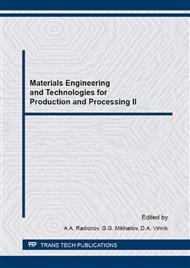[1]
S.A. Firstov, T.G. Rogul, O.A. Shut, Strengthening of polycrystals during a transition from the micro- to the nanostructured state, Physico-Chemical Mechanics of Materials. 6 (2009) 5-12. (in Russian).
Google Scholar
[2]
R.Z. Valiev, A.P. Zhilyaev, T.G. Langdon, Bulk Nanostructured Materials: Fundamentals and Applications, Wiley STM, USA (2014).
Google Scholar
[3]
R.Z. Valiev, О.А. Каibyshev, R.I. Кuznetsov, R Sh. Мusalimov, N.К. Tsenev, Of reports of Acad. Sciences of the USSR. 4 (1988) 864-866. (in Russian).
Google Scholar
[4]
F.Z. Utyashev, G.I. Raab, Deformation Methods of Fabrication and Processing of Ultrafine-Grained and Nanostructured Materials, Gilem, Ufa, 2013. (in Russian).
Google Scholar
[5]
V.I. Trefilov, V.F. Moiseev, E.P. Pechkovskiy, Strain Hardening and Fracture of Polycrystalline Materials, Naukova dumka, Kiev, 1987. (in Russian).
Google Scholar
[6]
Ya. Yu. Beigelzimer, V.N. Varyukhin, D.V. Orlov, S.G. Synkov, Twist Extrusion – Strain Deformation Process, TEAN, Donetsk, 2003. (in Russian).
Google Scholar
[7]
S.A. Firstov, Yu.N. Podrezov, V.I. Kopylov, M.I. Danylenko, Structural sensitivity of the mechanical properties of Armco iron subjected to equal-channel angular pressing, Metally. 1 (2004) 96-103. (in Russian).
Google Scholar
[8]
Yu.N. Podrezov, S.A. Firstov, Two approaches to analysis of strain hardening curves, High Pressure Physics and Technics. 4 (2006) 37-48. (in Russian).
Google Scholar
[9]
S.B. Goryachev, Microscopic Mechanisms of Strain Hardening, MEPhI, Moscow, 1984. (in Russian).
Google Scholar
[10]
A.M. Rosenberg, O.A. Rosenberg, M.S. Pasechnik, New Comprehensive Method for Testing Process Lubricants for Metal Forming, Kiev, 1971. (in Russian).
Google Scholar
[11]
V.V. Rybin, Large Plastic Strains and Fracture of Metals, Metallurgy, Moscow, 1986. (in Russian).
Google Scholar
[12]
М.І. Danylenko, Yu.M. Podrezov, S.A. Firstov, The influence of strain degree on the structural transformations and mechanical properties of the low-carbon steel 20Kh, in: Inter-University Collection: Naukovy Notatki, Lutsk, 2015, pp.42-46.
Google Scholar
[13]
G.V. Sarafanov, V.N. Perevezentsev, The effect of screening of disclination elastic field by the system of dislocations, Technical Physics Letters. 11 (2005) 936-938.
DOI: 10.1134/1.2136958
Google Scholar
[14]
V.N. Perevezentsev, G.F. Sarafanov, J.V. Svirina, Computer simulation of the dislocation ensemble kinetics in the elastic fields of mesodefects and fragmentation processes during plastic deformation, Materials Physics and Mechanics. 21 (2014).
Google Scholar
[15]
N.I. Danylenko, V.V. Kovylyaev, S.S. Ponomaryov, S.A. Firstov, in: Naukovy Notatki, part II, Lutsk, 2009, pp.69-72. (in Russian).
Google Scholar
[16]
T. Ekobori, Scientific Fundamentals of Strength and Fracture of Materials, Metallurgy, Moscow, 1971. (in Russian).
Google Scholar
[17]
J. Segurado, J. Lorca, I. Romero, Computational issues in the simulation of two-dimensional discrete dislocation mechanics, Modelling and Simulation in Materials Science and Engineering. 15 (2007) S361-S375.
DOI: 10.1088/0965-0393/15/4/s04
Google Scholar
[18]
E.M. Borysovska, Yu.N. Podrezov, Analysis of the dislocation annihilation process in the case of their chaotic disposition, in: the Collection Mathematical Models and a Computational Experimenting Materials Science, Kiev, 2006, p.116.
Google Scholar
[19]
E.M. Borysovska, Yu.N. Podrezov, S.A. Firstov, Dynamics of structural transformations taking into account dislocation nucleation, Electronic Microscopy and Strength of Materials. 14 (2007) 3-11. (in Russian).
Google Scholar
[20]
V.V. Rybin, Principles of microstructure formation in the process of plastic loading, Problems of Materials Science. 29 (2002) 11-33. (in Russian).
Google Scholar
[21]
V.V. Rybin, Regularities in the formation of meso-structures in the course of a developed plastic deformation, Issues of Materials Science. 29 (2002) 34-49. (in Russian).
Google Scholar
[22]
A.N. Orlov, V.N. Perevezentsev, V.V. Rybin, Grain Boundaries in Metals, Metallurgy, Moscow, 1980. (in Russian).
Google Scholar


